Expressing Opinions in the Early 18th-Century Republic of Letters
By Prof. Ann Thomson
The lecture by Ann Thomson has been paraphrased by PRIVACY Postdoctoral Researcher Frank Ejby Poulsen
Introduction and definitions
The focus of this paper is on how questions of the private appear in private correspondence and with regards to people’s behaviour in said correspondence. The empirical material used in the study consists of a selection of letters written by scholars (broadly defined - faculty members at universities, but also journalists, translators, publishers, writers, etc.) in the Republic of Letters.
The Republic of Letters has been widely studied and there are many varying approaches to the topic, among others:
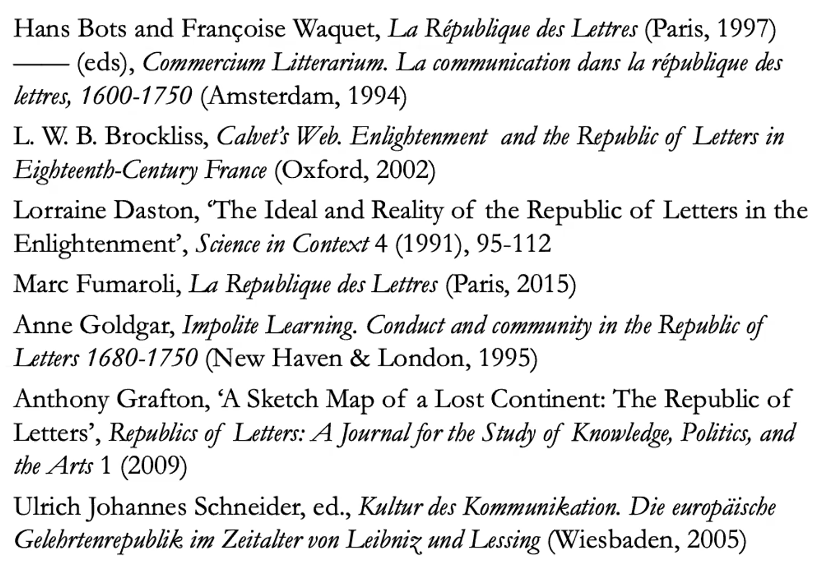
Lorraine Daston’s definition of the idealistic view of the Republic of Letters is based on Pierre Bayle’s work on the harmony of the Republic of Letters, disinterested learning, exchange, and equality. However, as many have pointed out, there were many violent disputes among members of the Republic of Letters, with insults both in public and private correspondence. Ann Goldgar’s book in particular discusses this topic.[1]
I use the term ‘the Republic of Letters’ to refer to a group of correspondence, which exists separately to correspondence between family or friends, in which things of common interest (publications, news, science, etc.) are discussed.
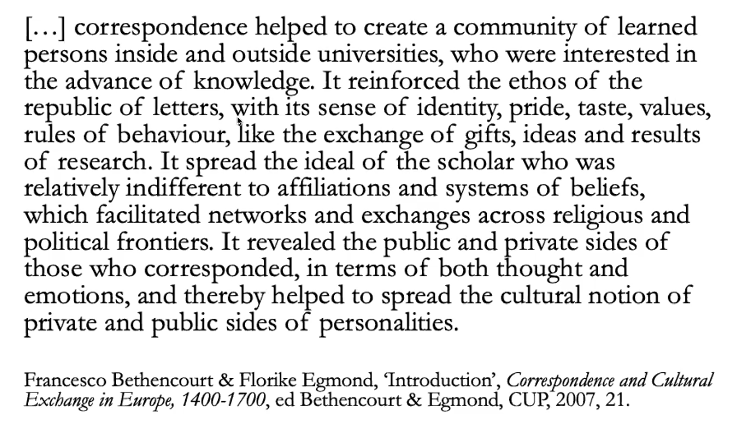
The Importance of Correspondence in the Republic of Letters
The people I work on were, for the most part, members of a network of Huguenot exiles after the revocation of the Edict of Nantes. Among them was Pierre des Maizeaux (1673-1745), whose enormous body of correspondence will soon be published. (Forthcoming: Lettres de La Motte à Pierre Maizeaux (1700-1744). Regard sur la librairie de Hollande au cours des premières décennies du XVIIe siècle. Text établi, introduit et annoté par Hans Born, Sébastien Drouen, Jan Schillinge, et Ann Thomson (Paris: Honoré Champion, 2021.)) Des Maizeaux was established in England and was an important hub for the Republic of Letters: he was ‘correcteur d’imprimerie’ [proofreader] for the French-speaking printing presses in Amsterdam, and he was also acting as a sort of agent. Therefore, his correspondence deals mainly with publishing (ideas, publications, news, etc.) as it also functions as business correspondence. He is one of the people I will discuss in this paper, although not the most important one.
This type of learned letter was an established genre, already defined by the Italian humanists. The first question to ask ourselves regarding these letters is: in what way can we say that these letters are actually private? They are clearly not private in the same way a personal letter to one’s family is. It is a different sort of private—they often have a more formal structure, they are private in the sense that they are familiar and not entirely formal, and in theory they are not intended for publication the way certain other types of letters were. At the same time, it is known that such letters did circulate amongst a restricted group of people and that they were sometimes read aloud to this group. Some examples of these readings have been studied, but it is difficult to know in which cases letters were read aloud to a group with any certainty. So, the line between the public and the private is blurred in the case of these letters.
It is worth remarking on how such correspondence required an initial establishment of confidence and trust between correspondents. The ideal of the Republic of Letters was that one could express one’s opinions freely. There were specific ways of establishing this trust. An example of mistrust can be found in a letter from a journalist in The Hague named Bernard written to Pierre des Maizeaux in 1702, warning him that another journalist working for the Jesuit Mémoires de Trévoux wanted to establish a correspondence with him. As Bernard warned Des Maizeaus, this man was ‘un esprit un peu dangereux’ (a dangerous mind), so if Pierre chose to write back to the other journalist he should be careful. This clearly indicates a need for confidence among correspondents.
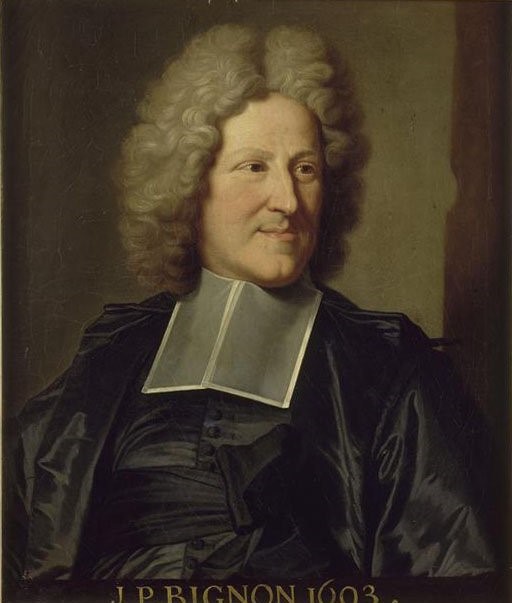
On the other hand, an example of trust can be found in the letter that Jean-Paul Bignon (1662-1743)—leading figure in the French Republic of Letters, directeur du Journal des savants, and future king’s librarian—wrote to Pierre des Maizeaux in 1708. In this letter he wrote that he wanted to establish a learned correspondence, but only to discuss literature between ‘pures esprits’ (pure minds). He adds that if his name should frighten Des Maizeaux, and if he should fear being compromised, they could always use false names, so that none of their real names would appear on the outside of the envelopes. This practice was called ‘souscription’ in French. Pierre des Maizeaux replied that he did not mind:
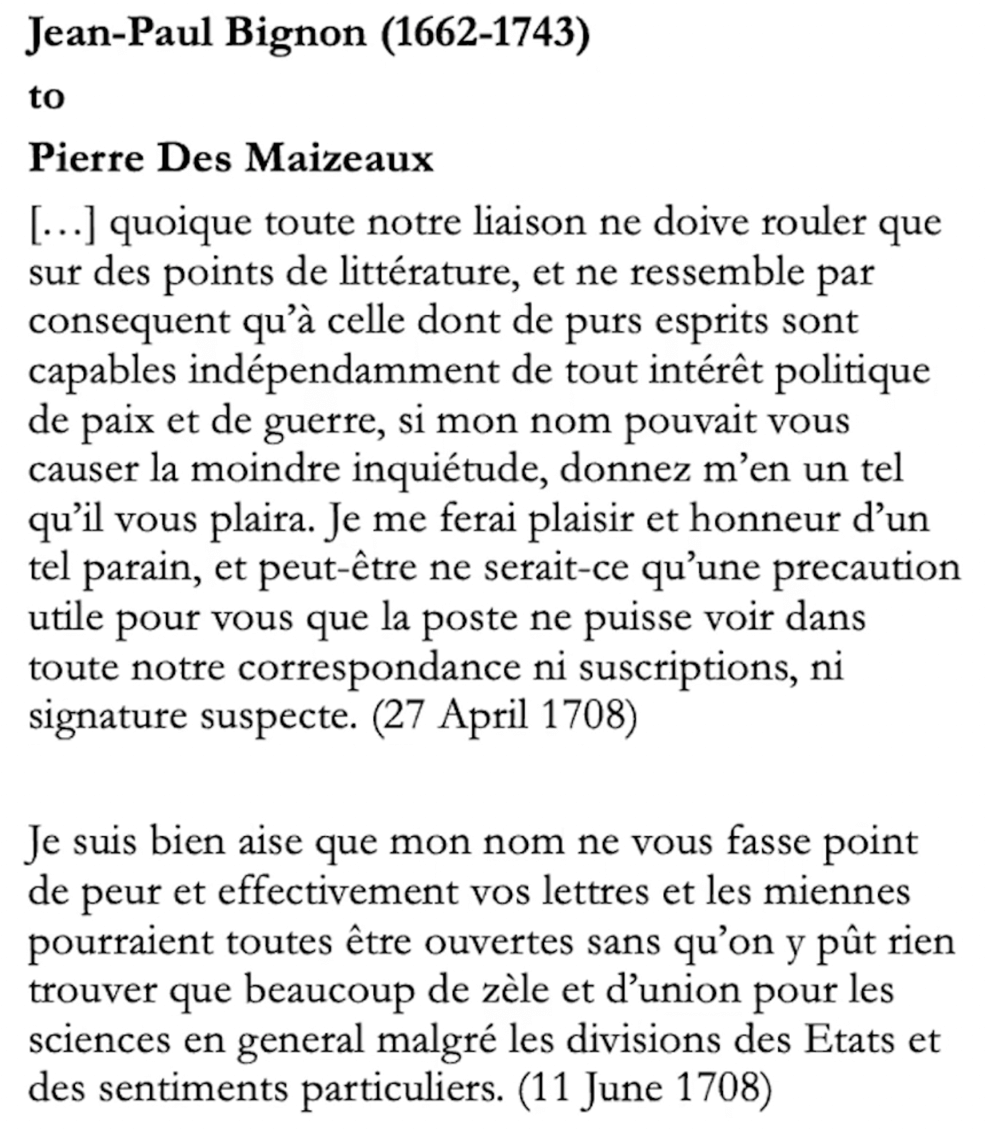
‘Our letters could be opened without anyone finding anything in them save our unifying zeal for the sciences despite the divisions between states and individual temperaments.’ There was mutual respect and confidence. This also leads to a point about letters sent through the official post. There was, of course, a danger that they might be opened and read, and hence concerns regarding their privacy. To avoid this risk, letters were often sent via personal contacts, and usually via particular networks. By sending the letter with someone you knew was travelling to the destination of the letter, you could remain private and avoid prying state eyes.
Cross-confessional correspondence
As we can see from this correspondence between Bignon and Des Maizeaux, some correspondents communicated across confessional lines—Bignon being a Catholic and Des Maizeaux an exiled Protestant. There are two aspects of these interconfessional correspondences that I want to focus on. First, I would like to focus on the greater liberty with which they expressed heterodox opinions through these correspondences than they would have been able to otherwise, since no-one would have wanted to put such opinions in writing connected to their real name. Second, I would like to focus on the manner in which these religious differences were expressed.
1. Liberty to express heterodox opinions in cross-confessional correspondence
An interesting correspondence is one which took place in Switzerland between Louis Bourguet and Jean Bouhier.
 |
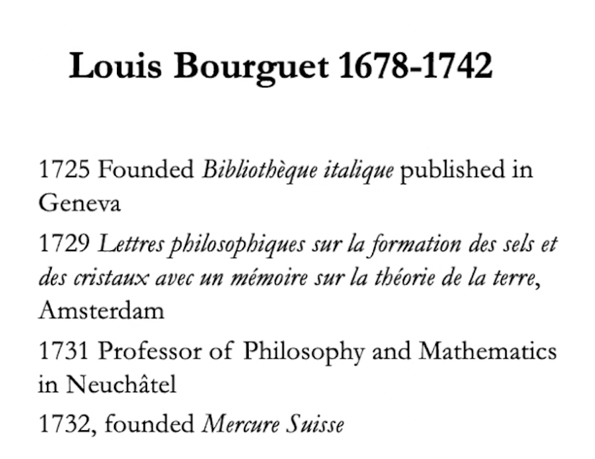 |
 |
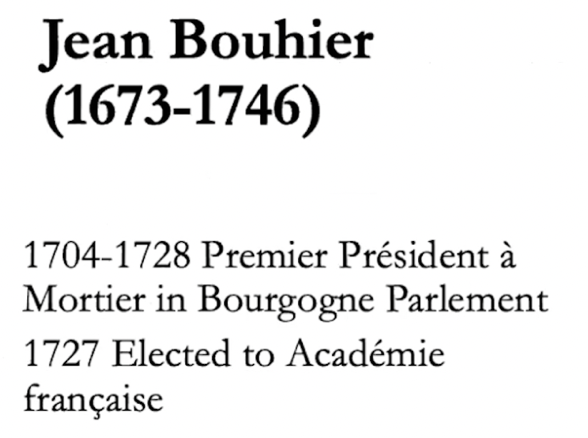 |
Louis Bourget was a Huguenot exile who established himself in Neuchâtel, where he taught philosophy and mathematics. He was a scientist and had a large network of correspondence with other Huguenots, but also with many people in Italy, as he had spent a good deal of time there in his youth. He had been in Italy as a representative for his family business; a career which he subsequently abandoned to become an intellectual. Jean Bouhier was a highly important person in France. Firstly, he was president of the Parliament of Burgundy in Mortier (1704-1728) and was elected to the Académie Française in 1727. He was a Catholic, a faithful member of the church, though he occasionally expressed heterodox views. Through Bourguet, Bouhier also corresponded with someone called Caspar Cuenz. We do not know much about him, but he published an unusual piece of work which I will discuss below.
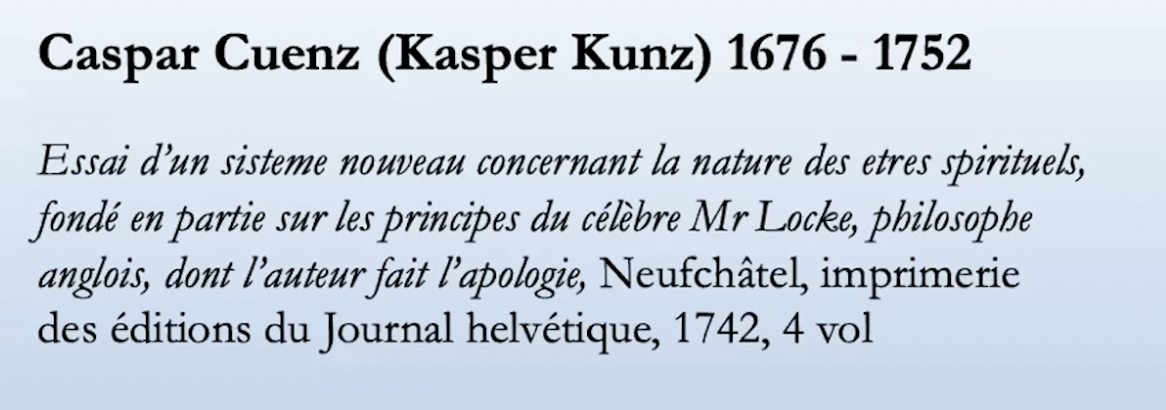
Before entering further into the matter of these correspondences, it is worth briefly touching on some of the subject matter covered in the letters. Without going into too many philosophical details, an important discussion in the early eighteenth century focused on the nature of matter and the soul. Questioning the existence of an immortal soul, and classifying the soul as matter, was seen as heterodox and even Spinozist and atheist. The debate was prominent in early eighteenth-century England, and was connected to Locke’s hypothesis of thinking matter. Now, Louis Bourguet was extremely hostile to these sorts of ideas, and he called them materialist and Spinozist, not even deist but pantheist:
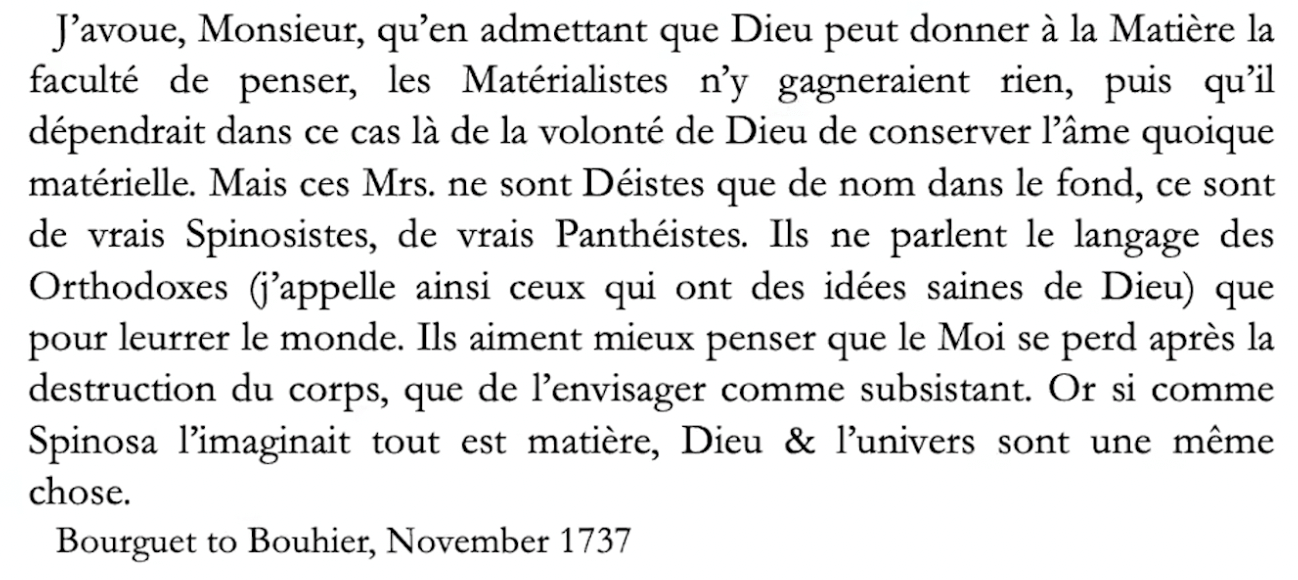
Interestingly, Bouhier disagrees:

He says: ‘it is true that some libertines might abuse this notion, but it is in fact not against religion to say that the soul is material, and there is no reason to reject this idea. It was even the belief of certain of the church fathers. So, one can accept this’. This is, in fact, a deeply shocking point of view, even if Bouhier writes that it is in line with Christian teaching. Anyone who expressed this view was immediately branded as a Spinozist, as Bourguet rightly wrote. The view that the soul was matter was censored in England in the early eighteenth century, and certainly could not have been published in France. Bouhier himself would never have stated this opinion publicly, let alone have published it. Yet he was willing to write it in a private letter, even if it was addressed to someone of a different religion—a Protestant.
The same discussion continued between Bouhier and Bourguet’s friend Cuenz. Bouhier writes:

‘You cannot deny God the power to make matter immortal.’ He repeats that several of the church fathers believed in the materiality of the soul, which was not against religious doctrine:
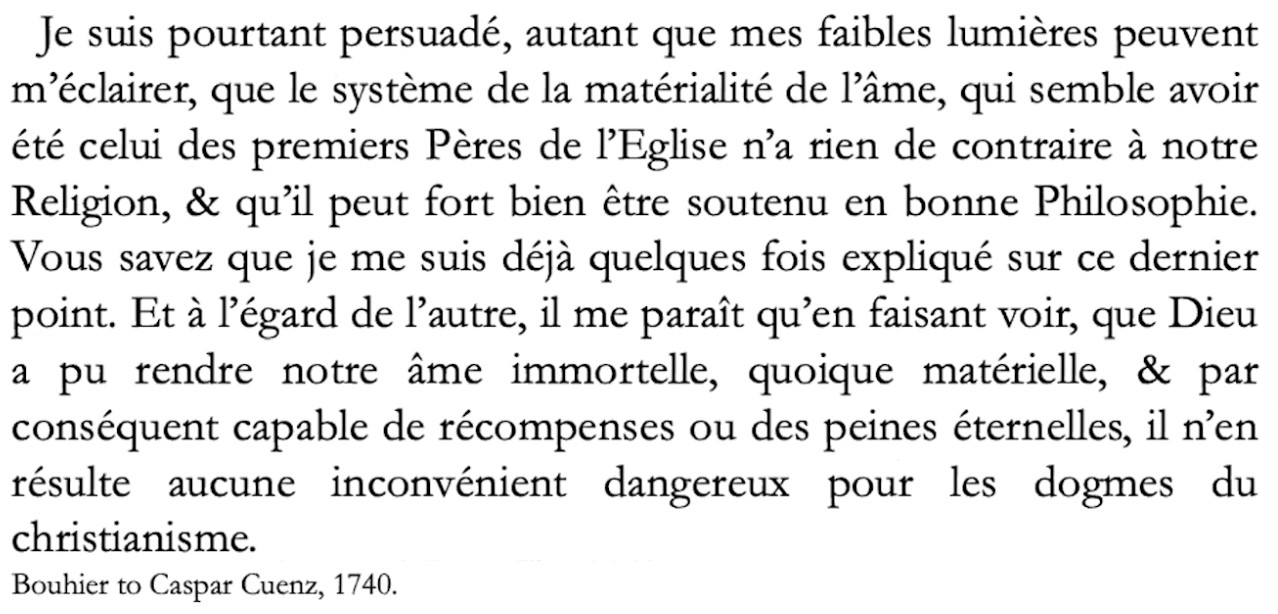
In both quotations Bouhier states that the idea of the materiality of the soul is not against religious doctrine at all, and that one can defend it, philosophically speaking. There is no danger to Christianity, according to him. Again, it must be emphasized that he would never have published this opinion openly.
It is clear that Bouhier, in fact, followed the same discussion as it took place in England thirty years earlier. He advised Cuenz to go and look up an article in a journal from the beginning of the century about this debate in England.
I have made my first point, which is that it was possible, in this sort of private correspondence, for people to express views that they themselves considered them to be in line with their religion, despite them being generally considered totally unacceptable and atheistic or deistic; views which these people would never have published openly. A Catholic like Bouhier had enough confidence in some of his Protestant correspondents to express these views in letters addressed to them.
This brings me to my second point about cross-confessional dialogues.
2. Expression of private religious opinions in cross-confessional correspondence
In general, scholars like Bouhier and Bourguet would, when discussing matters of scientific or literary interest, avoid discussing any controversies between Catholics and Protestants. The ideal of the Republic of Letters was that religious differences were irrelevant and that one kept one’s own religious opinion to oneself. One did not even express one’s religious opinions in private correspondence - this was one of the unwritten rules of the Republic of Letters. One was only supposed to discuss abstract matters such as literature and philosophy, and avoid dangerous topics. However, as was discussed by Anne Goldgar in her aforementioned book about the Republic of Letters, this was more a principle than a fact. This is what I would like to discuss here: to what extent did people express their private religious opinions in cross-confessional correspondence?
In order to examine this matter, I’d like to discuss a letter from the Abbé Bignon to Jean Le Clerc (1657—1736). Le Clerc was another exiled Huguenot in Holland and an important intellectual. He was a highly respected journalist. The letter is a private one (though rather formal,) in which Bignon compares Le Clerc to Hugo Grotius and writes that ‘your idea of reuniting the churches together resembles his’ and ‘you are like him because you want to get rid of all these disagreements amongst Christian societies.’ Furthermore, Bignon writes that there is nothing wrong with people of letters disagreeing with each other, but that the discussion should never become personal, but should be like Le Clerc himself—polite and moderate. At the end of the letter, Bignon writes about noble and philosophical insensitivity to disputes or taking offence.
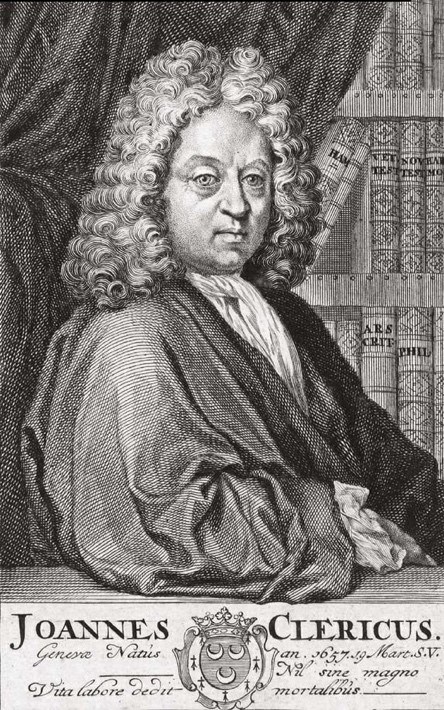 |
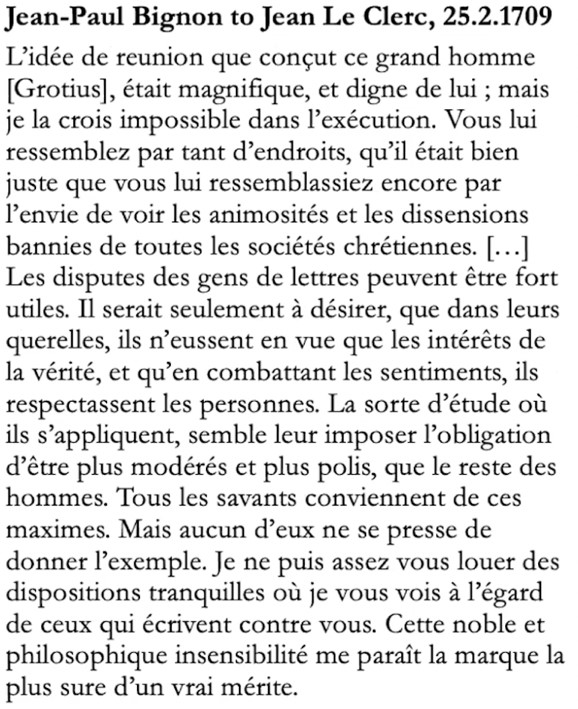 |
In fact, Le Clerc was anything but polite and moderate. He spent his time fighting with many people. This ideal that Bignon is expressing is, as we see here, very difficult to live up to and is in fact beyond most people.
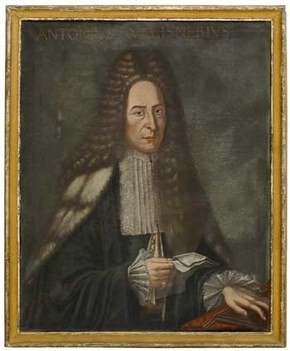
Lydia Barnett discusses this issue in her article ‘Strategies of Toleration: Talking across Confessions in the Alpine Republic of Letters’, Eighteenth-Century Studies, 48 (2015), 141-57. She analyses the correspondence between Bourguet and Antonio Vallisneri (1661—1730) and how they did or did not bring up religious questions.
Here, I would like to touch on Bourguet’s correspondence with Bouhier, which was a long one. They discussed erudite matters such as Etruscan antiquities. They showed great respect for each other and even cooperated on the Swiss publication of a work written by Bouhier. The book is an amusing retelling of a famous sixteenth-century case where a wife had demanded the annulment of her marriage due to her husband’s impotence. Bouhier argued for the reinstatement of the ‘épreuve du congrès’, which was a demonstration before experts of the husband’s capacity for intercourse. This is an argument for a clear invasion of privacy, and the two men collaborated clandestinely in France because there were rules, set in place in order to defend French printers, regarding bringing foreign works into France.
|
They kept to the ideal of correspondence – avoiding religious discussion - for a long time. They kept repeating the fact that they shared the same religion, the same ideas, that they agreed on fundamental doctrines. Bouhier wrote: ‘it would be strongly desirable that we had stayed with the simplicity of the original church. But people needed ceremonies…’ At the end of the extract, he wrote that ‘il faudrait être en tête-à-tête’—in other words, they should only discuss this face to face. This shows that these questions are dangerous: criticizing the ceremonies of one’s own church is indeed a delicate subject. |
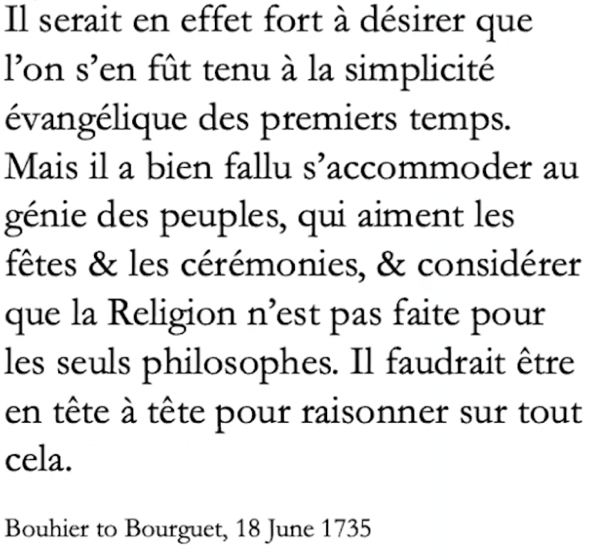 |
They kept to the ideal of correspondence – avoiding religious discussion - for a long time. They kept repeating the fact that they shared the same religion, the same ideas, that they agreed on fundamental doctrines. Bouhier wrote: ‘it would be strongly desirable that we had stayed with the simplicity of the original church. But people needed ceremonies…’ At the end of the extract, he wrote that ‘il faudrait être en tête-à-tête’—in other words, they should only discuss this face to face. This shows that these questions are dangerous: criticizing the ceremonies of one’s own church is indeed a delicate subject.
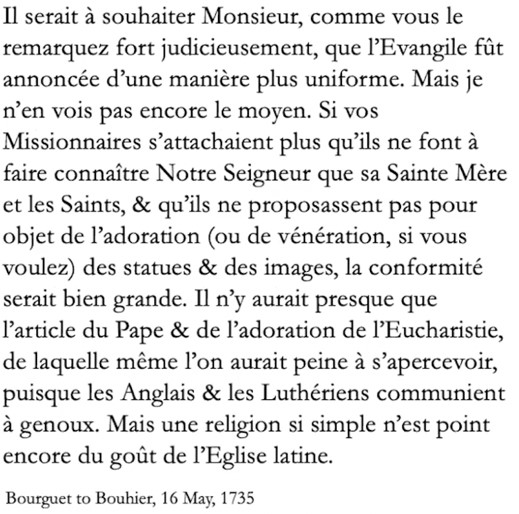
|
Bourguet, on the other hand, was rather more aggressive. He agreed that religion should be expressed more simply, but laid the blame at the feet of Catholic missionaries who, instead of talking about Jesus, talked about the Holy Mother and the saints, and the worship of saints and images. ‘Indeed, they should stick to simplicity,’ he wrote, ‘but that is not in the taste of the Latin Church.’ Here, Bourguet started to introduce criticism of the Catholic Church in his letter to Bouhier. |
After this, both of them began to insist on the ignorance of the other. Bouhier wrote that he did not really want to enter a religious argument, but he pointed out that he was very glad that to have been born in a church that could trace its roots back to the apostles. In other words, he was arguing that his church was the true church. He continued to write that he and Bourget would have the same views if not for the Protestant ministers and professors who were opposed to this reunion. Here, Bouhier criticized the Protestants, though he then finally admitted that the correspondence had slid into controversial territory, which is what they were supposed to avoid. So he ended by stating that they must respect individual people in choosing what they believe to be the true religion.

Bourguet answered that he respected Bouhier, and did not know either how they had slid into such controversial matter, though he stated that he had a terrible opinion of the Roman Church.
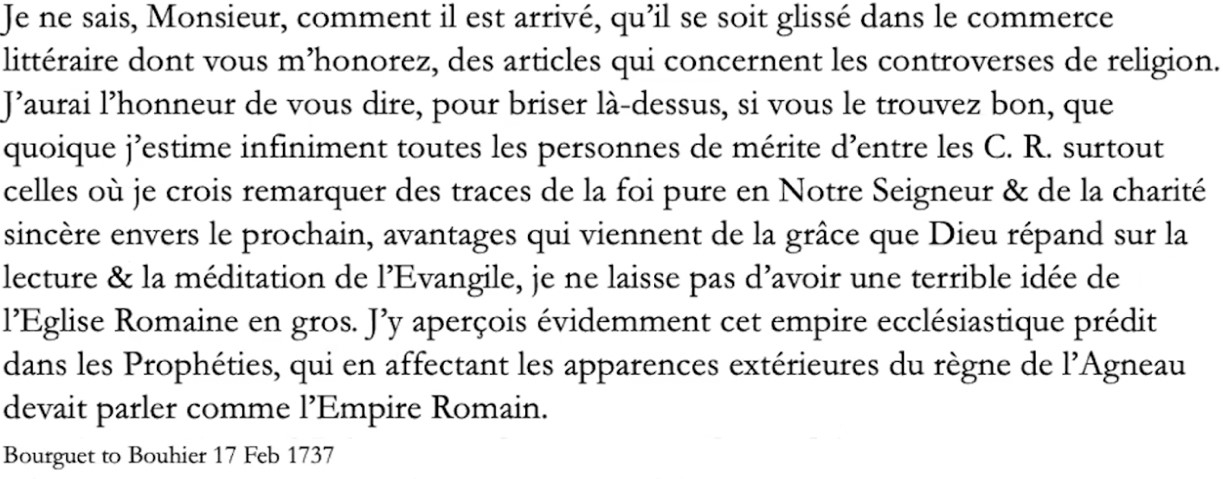
Bouhier agreed: ‘I do not know how we have begun to disagree.’ He added that ‘it is probably because you spent so much time in Italy that you have a bad opinion of our church’. The problem, he wrote, is that there was too much deism and atheism. And why was this? Because of the Protestant refugees like Bayle, who had introduced dangerous foreign works, which lead either to irreligion or to indifference towards religion. So, Bouhier thought that it was much more important to attack atheists and irreligious people than to attack people who followed other religions than Catholicism. Still, he attributed the spread of atheism to Protestants.

Here, we can see an example of religious discussion across the religious divide, despite the Republic of Letters ideal that one should keep one’s religious opinion to oneself. What started as an agreement about the union of religions gradually slid into invective and criticism of each other’s religions. In this case it is the Protestant who is more vituperative than the Catholic. At the same time, however, we do see in other letters, where people are writing to people of their own religion—whether it is Bourget to his Protestant friend in Lausanne, or Bouhier or Vallisneri to their Catholic friends—they were much more hostile towards other religions. Vallisneri ridiculed Bourguet in his letters for literally believing in the stories told in the Bible, such as the story of the flood. Bourguet wrote to his friends, mocking the idiocy of the Italians and their credulity, and claiming that that they had to defend the Protestant religion and shut the mouth of the papists. We see that in cross-confessional correspondence people had to keep certain opinions to themselves because their real opinions were, in fact, deeply hostile. They could manage to have productive discussions in the Republic of Letters only if they kept these opinions to themselves.
Final example
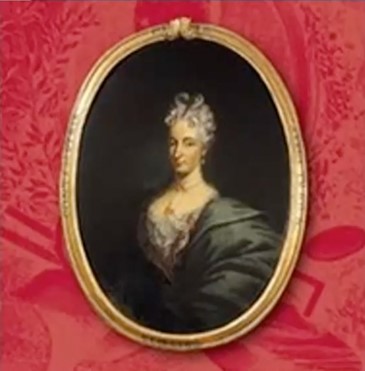
A final example of flouting these unspoken rules is that of the Countess Clelia Grillo Borromeo Arese (1684—1777). She was at the top of the aristocratic hierarchy. She was a respected member of the Republic of Letters, a philosopher and a mathematician who received extravagant praise from a large number of members of the Republic of Letters. Several people even dedicated their works to her. She was a very important person in society, and was in touch with Bourget through Vallisneri. She tried to convince Bourguet to come to Milan to become a member of an academy that she was trying to create—although she did not succeed in creating it at an official level, and it remained only informal.
Clelia Grillo was very much aware that, even though she was part of the Republic of Letters, she was an outsider, as she wrote in several letters. She was an outsider both because she was a woman in a male-dominated space, but also because of her social position. As a countess, she had duties to undertake and did not receive the same education many of the other had. As a result, while male members of the Republic of Letters could express self-deprecation a certain way, she went a lot further. Her letters are full of remarks about her inadequacy, about the fact that she cannot concentrate on one subject, how she does not have the patience to read long works, how she flits from one interest to another, that she was destined for the distaff and therefore did not have the necessary scientific knowledge, and so on.
She is completely aware of the unwritten rules of the Republic of Letters as this letter to Bourguet in 1725 shows. Bourguet had expressed worry about the serious illness of a friend. She writes to him that he would have been happier and received more consolation if he had been a member of the Catholic Church, because he would have been assured of the intercession of the saints on his behalf, who could have calmed the Almighty and convinced Him to suspend the affliction. In this letter Clelia Grillo tries to convert Bourguet to the Catholic Church by talking about the intercession of the saints, which would have been horrific to a Protestant like Bourguet. To Protestants, the worship of Saints was the worst type of fanaticism. However, she might be aware that she is crossing a line, because she writes that this is probably a useless digression. Still, she writes as she talks, and she says what comes to her mind.
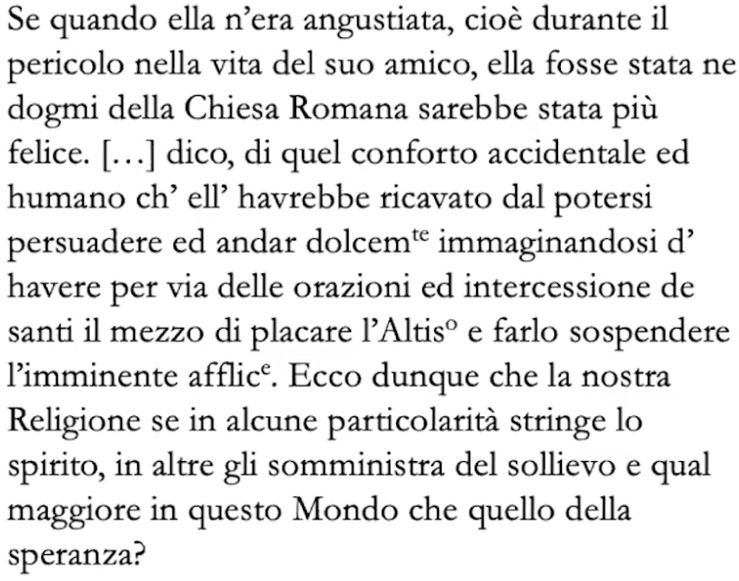

This indicates the relationship between a private letter and a private conversation, and the rules that govern these letters. Grillo Borromeo may not be a typical example but it is nevertheless interesting to examine correspondence written by an upper-class woman, who perhaps may not be as aware of the unwritten rules as she should be. Bourguet spent two months before replying to Borromeo. He ignored her comments on the saints, and did not write anything in response to this.
Concluding remarks
This was a rather impressionistic survey of certain aspects of this type of correspondence. There are many other aspects that the historian could discuss regarding private correspondence: how much do the letters tell us about private life; how much are emotions discussed. From what I have focused on, what arises from this correspondence is a differentiation between levels of privacy. What do we mean precisely by a private correspondence? What is special about the Republic of Letters? What are the diff
The lecture by Ann Thomson has been paraphrased by PRIVACY Postdoctoral researcher Frank Ejby Poulsen
